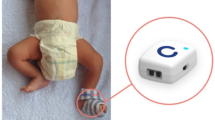Abstract
In this text we present the design of a wearable health monitoring device capable of remotely monitoring health parameters of neonates for the first few weeks after birth. The device is primarily aimed at continuously tracking the skin temperature to indicate the onset of hypothermia in newborns. A medical grade thermistor is responsible for temperature measurement and is directly interfaced to a microcontroller with an integrated bluetooth low energy radio. An inertial sensor is also present in the device to facilitate breathing rate measurement which has been discussed briefly. Sensed data is transferred securely over bluetooth low energy radio to a nearby gateway, which relays the information to a central database for real time monitoring. Low power optimizations at both the circuit and software levels ensure a prolonged battery life. The device is packaged in a baby friendly, water proof housing and is easily sterilizable and reusable.
Access this chapter
Tax calculation will be finalised at checkout
Purchases are for personal use only
Similar content being viewed by others
References
WHO: Thermal Control of the Newborn: a Practical Guide. Maternal and Safe Motherhood Programme (1993)
WHO: Newborn deaths decrease but account for higher share of global child deaths (2012)
WHO, UNICEF, and UN: Levels and Trends in Child Mortality Report (2012)
Omre, A.H.: Bluetooth low energy: wireless connectivity for medical monitoring. J. Diab. Sci. Technol. 4(2), 457–463 (2010)
Artem, D., Steve, H., Stuart, T., Joshua, S.: Power consumption analysis of Bluetooth low energy, Zigbee, and ANT sensor nodes in cyclic sleep scenario. In: IEEE International Wireless Symposium, Beijing (2013)
Bluetooth: Health temperature profile (2012). https://developer.bluetooth.org/TechnologyOverview/Pages/HTP.aspx
Boano, C., Lasagni, M., Romer, K., Lange, T.: Accurate temperature measurements for medical research using body sensor networks. In: 14th IEEE International Symposium on Object/Component/Service-Oriented Real-Time Distributed Computing Workshops (ISORCW) 2011, pp. 189–198 (2011)
Cantherm: High precision ntc thermistors (2009). http://www.cantherm.com/products/thermistors/mf51e.html
Chen, W., Dols, S., Oetomo, S. B., Feijs, L.: Monitoring body temperature of newborn infants at neonatal intensive care units using wearable sensors. In: Proceedings of the Fifth International Conference on Body Area Networks, BodyNets 2010, pp. 188–194, New York. ACM (2010)
Embrace: A low cost infant warmer (2012). http://embraceglobal.org/
Health, G.: Causes of neonatal and child mortality in India: a nationally representative mortality survey. Lancet 376(9755), 1853–1860 (2010)
Gomez, C., Oller, J., Paradells, J.: Overview and evaluation of bluetooth low energy: an emerging low-power wireless technology. Sensors 12(9), 11734–11753 (2012)
Montgomery-Downs, H.E., Insana, S.P., Bond, J.A.: Movement toward a novel activity monitoring device. Sleep Breath 16(3), 913–917 (2012)
Isetta, V., Agustina, L., Lopez Bernal, E., Amat, M., Vila, M., Valls, C., Navajas, D., Farre, R.: Cost-effectiveness of a new internet-based monitoring tool for neonatal post-discharge home care. J. Med. Internet Res 15(2), e38 (2013)
iThermometer: Bluetooth digital thermometer for android devices (2012). http://download.chinavasion.com/download/CVXX-A140.pdf
Kumar, V., Mohanty, S., Kumar, A.: Effect of community-based behaviour change management on neonatal mortality in shivgarh, Uttar Pradesh, India: a cluster-randomised controlled trial. Lancet 372(9644), 1151–1162 (2008)
Kumar, V., Shearer, J.C., Kumar, A., Darmstadt, G.L.: Neonatal hypothermia in low resource settings: a review. J. Perinatol. 29, 401–412 (2009)
Macfarlane, F.: Paediatric anatomy, physiology and the basics of paediatric anaesthesia (2006)
Neurosynaptics (2002). http://www.neurosynaptic.com/
Oestergaard, M.Z., Inoue, M.: Neonatal mortality levels for 193 countries in 2009 with trends since 1990: A systematic analysis of progress, projections, and priorities. PLoS Med 8(8), e1001080 (2011)
Rutter, N.: Clinical consequences of an immature barrier. Semin. Neonatology 5(4), 281–287 (2000)
Scavacini, A.S., Miyoshi, M.H., Kopelman, B.I., Peres, C.D.A.: Chest expansion for assessing tidal volume in premature newborn infants on ventilators. Jornal de Pediatria 83, 329–334 (2007). Please check and confirm inserted author name and initials is correct in Ref. [22]
Stratasys High-quality, precise, multi-material prototypes in a compact system (2013). http://www.stratasys.com/3d-printers/design-series/precision/objet260-connex
Susan, B., Debra, D., Lori, A.L.: Neonatal thermal care, part II: microbial growth under temperature probe covers. J. Neonatal Netw. J. Neonatal Nurs. 20, 19–23 (2001)
TI: 2.4ghz inverted f- antenna (2008). http://www.ti.com/lit/an/swru120b/swru120b.pdf
Acknowledgements
We acknowledge the Robert Bosch Center for Cyber Physical Systems at the Indian Institute of Science for funding support.
Author information
Authors and Affiliations
Corresponding author
Editor information
Editors and Affiliations
Rights and permissions
Copyright information
© 2015 Springer International Publishing Switzerland
About this paper
Cite this paper
Rao, H. et al. (2015). Design of a Wearable Remote Neonatal Health Monitoring Device. In: Plantier, G., Schultz, T., Fred, A., Gamboa, H. (eds) Biomedical Engineering Systems and Technologies. BIOSTEC 2014. Communications in Computer and Information Science, vol 511. Springer, Cham. https://doi.org/10.1007/978-3-319-26129-4_3
Download citation
DOI: https://doi.org/10.1007/978-3-319-26129-4_3
Published:
Publisher Name: Springer, Cham
Print ISBN: 978-3-319-26128-7
Online ISBN: 978-3-319-26129-4
eBook Packages: Computer ScienceComputer Science (R0)




